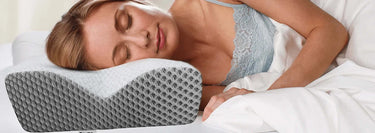A Smarter Alternative to the 45-Degree Pillow

Scroll through leg wedges online and you will see the same phrase everywhere: “45-degree pillow.” It sounds precise, even scientific. But once you lie down on a rigid 45-degree incline for more than a few minutes, a simple truth shows up fast: the angle is working harder than your body is. Your knees feel pushed, your hips start to fight the slope, and your lower back has to negotiate with gravity rather than relax into balance.
Zen Bloks® took a different path. After years of real testing on beds, sofas, and studio floors, the final design did not land on a single number. It landed on a dual-angle profile: roughly a 65-degree rise near the base that transitions into a gentler 35-degree loft under the calves. That shift in geometry turns a static wedge into a structured support that matches how people actually rest.

How the 45-Degree Wedge Became “Standard”
The 45-degree angle did not come from years of ergonomic testing on real beds. It came from a geometry that was easy to manufacture and market. A single triangle is simple to cut from foam. A round number is easy to print on packaging. For many brands, that was enough.


The problem is that a single sharp incline can ask too much of the body:
- Knees are pushed forward instead of resting in a neutral bend.
- Hips are tilted so the pelvis feels twisted rather than supported.
- Lower backs often arch away from the mattress or cushion, increasing tension instead of easing it.
- Calves slide down the face of the wedge, so you keep adjusting position instead of settling in.
In short, a rigid 45-degree ramp looks clean in a photo, but it does not match the natural curves of the body. Over long sessions, that mismatch turns into stiffness, restlessness, and extra effort from your core muscles to keep everything from sliding.
What Dual-Angle Elevation Really Means
![]()
Instead of locking users into one steep slope, the Zen Bloks® wedge uses a two-stage profile:
- Base rise around 65 degrees near the thighs to create a strong lift where your legs are heaviest.
- Gentler loft around 35 degrees under the calves so your lower legs can relax into the surface instead of fighting it.
That shape did not come from a drafting table. It came from years of testing different cut patterns on actual people in actual homes, quietly adjusting small details:
- The point where the angle transitions under the knee.
- How high the heel sits relative to the hip.
- How broad the platform under the thighs needs to be to feel stable.
Dual-angle elevation keeps the lift where it matters and softens the slope where the leg needs to rest. The result is a floating feeling instead of a “perched on a ramp” feeling.
Angle Comparison: 45-Degree Wedge vs Dual-Angle Design
Numbers never tell the whole story, but they help visualize why the experience is so different.
| Feature | Generic 45° Wedge | Zen Bloks® Dual-Angle Wedge |
|---|---|---|
| Primary angle under thighs | Single 45° incline from base to top | Approx. 65° rise for solid lift where legs are heaviest |
| Calf support angle | Same 45° angle, often too steep for lower legs | Transitions to roughly 35° for a softer landing under the calves |
| Contact area under legs | Smaller surface area, more pressure on a narrow band | Broader contact from thigh to ankle for even pressure distribution |
| Body tendency | Legs tend to slide down; the user keeps scooting up | Body settles into the angle, less sliding, more stability |
| Lower back response | Often creates an arch that increases tension | Designed to support neutral alignment across the hips and lumbar area |
The takeaway is simple: a single angle serves the foam cutter, not the body. The dual-angle design recognizes that thighs, knees, and calves each have different jobs and weights.
How Angle Changes Affect Knees, Hips, and Lower Back

When elevation is set up correctly, your body does not feel “held up.” It feels like gravity has been redirected in your favor. A well-designed wedge:
- Let's knees rest in a relaxed bend instead of a sharp hinge.
- Supports the back of the thighs so the foam carries the weight of the legs, not the lower back.
- Maintains a gentle slope from hip to heel, which encourages smoother circulation and less end-of-day heaviness.
- Keeps ankles from hanging unsupported, which can create tension in the shins and feet.
On a rigid 45-degree wedge, the leg often forms a peak at the knee, with too little support underneath. The body responds by tightening around the joints to stay stable over time, which can mean more stiffness, not less.
By contrast, the Zen Bloks® dual-angle profile lets your legs rest in a calm arc. The upper stage delivers strong lift, the lower stage smooths out the angle so your calves and ankles do not feel like they are hanging off a ledge. The result is less fidgeting and a stronger sense of being “held” rather than “perched.”
Why Foam Density And Structure Matter More Than Softness
Angle alone cannot carry your legs. Foam density and structure decide whether that angle stays put after hundreds of sessions. Many inexpensive wedges rely on low-density foam that feels plush at first but compresses into a flatter slope over time.
Zen Bloks® uses high-density, performance-grade foam tuned for two goals:
- Maintain the dual-angle profile under real body weight.
- Provide a stable platform that still feels comfortable for long sessions.
Think of it more like a supportive seat in a performance car than a soft cushion. The structure underneath is doing the work so your body does not have to.
| Foam type | First few uses | After months of regular use |
|---|---|---|
| Low-density generic foam | Soft, “sink-in” feeling that seems cozy at first | Angle collapses, legs sit lower, support becomes inconsistent |
| Zen Bloks® high-density core | Feels structured and supportive from day one | Maintains shape and elevation, even with daily routines |
Firm does not mean harsh. It means the wedge holds its promise over time. Soft foam feels friendly in the box but often leads to sagging, uneven elevation, and that familiar “why does this feel flatter than it used to?” moment within a few months.
Using Dual-Angle Support On The Bed, Sofa, And Floor
The dual-angle design is built for everyday life, not a perfect studio photo. It works in three main environments where people actually unwind:
Bed: Evening Wind-Down And Quiet Time
In bed, the wedge sits close to the hips so the broader base supports the upper legs. The gentler loft keeps calves supported without forcing toes straight up. Many users spend 20 to 40 minutes in this position while reading, scrolling, journaling, or simply letting the day settle.
For a step-by-step walkthrough of positioning, visit the leg elevation setup guide in the Learn Center.
Sofa: Streaming Sessions And Creative Work
On the sofa, the dual-angle profile really shows its value. The stronger base angle keeps the thighs supported even on soft cushions, while the lower calf angle prevents that “sliding off the wedge” feeling during long streaming sessions or laptop work.
Many people keep their wedge near the living room seating so leg elevation becomes part of movie nights or editing sessions instead of something that only happens in a bedroom.
Floor: Mats, Studio Work, And Recovery Spaces
On a firm surface like a yoga mat or studio floor, the high-density foam has nowhere to sink. That is where the structure really stands out. The curvature keeps the legs cradled while the body rests fully supported on the back, making it easier to breathe deeply and release lower-body tightness.
Some wellness professionals use this setup during guided breathing or light stretching sessions so clients can focus on the practice rather than on how to prop their legs.
Who Benefits Most From Structured Dual-Angle Elevation
A dual-angle wedge is not only for one type of user. The design was shaped by feedback from:
- Active professionals who stand or walk most of the day and want a reliable way to ease leg heaviness at night.
- Desk and studio workers who sit through long editing or computer sessions often experience tightness building across the lower back and hips.
- Tradespeople and travelers who carry gear, climb ladders, or log serious road hours need a simple home routine for recovery.
- Wellness-focused households are building a small toolkit for daily relaxation and better posture habits.
All of these users share one thing: they are not looking for a quick gimmick. They want structured comfort that fits into a real schedule and holds up year after year.
For a deeper look at how the complete Zen Bloks® system was engineered, visit the ergonomic design overview.
Height, Sizing, And Setup Resources
Angle is only half the story. Height also matters. Zen Bloks® leg wedges come in different lofts so that taller and shorter users can keep their thighs and calves supported without forcing the knees.
- 10-inch model often works well for users around the middle height range.
- 11-inch model is tuned for taller users who need more lift to reach the same balanced angle.
To decide which height makes sense for you, start with the guidance on the timing and use page, which walks through common scenarios and body sizes.
When you are ready to compare options side by side, head to the main collection and review the available wedges in detail on the structured leg support lineup.
Common Questions About 45-Degree Wedges vs Zen Bloks® Dual-Angle Design
Q: Why not keep everything at 45 degrees if that angle is so popular?
A single 45-degree slope is easier to manufacture but does not match how legs naturally rest. The upper and lower sections of the leg have different weights and roles. The dual-angle design provides stronger lift where it is needed and a gentler slope where the body should relax, leading to better alignment and less frequent repositioning.
Q: Does the firmer foam feel uncomfortable at first?
Many people are used to very soft cushions, so the first impression of a structured wedge can feel different. Within a few sessions, most users notice that the firm, high-density foam actually makes it easier to stay comfortable for longer because the angle does not collapse and the body does not have to keep working to stay in place.
Q: How long should I elevate my legs on the wedge?
A typical routine is 15 to 30 minutes at a time, once or twice per day. Some users extend that based on how they feel. The key is consistency. Make leg elevation a small, repeatable part of your daily rhythm rather than something you do only when discomfort peaks. The Learn Center’s setup guide offers simple starting routines.
Q: Is the dual-angle wedge only for people who already use leg elevation?
Not at all. Many customers had never used a wedge before Zen Bloks®. They noticed end-of-day tightness, heavy legs, or lower back fatigue and wanted a structured way to reset. The dual-angle profile is a straightforward starting point that feels intuitive even on day one.
Q: Can I pair the leg wedge with a seat cushion or cervical pillow?
Yes. Many households combine the leg wedge with an ergonomic seat cushion or a structured neck support so posture habits remain consistent throughout the day. If you sit for long stretches, consider the XL gel seat cushion in the primary sitting support option as a complement to your evening elevation routine.
Compliance note: Zen Bloks® products are designed for ergonomic comfort, posture support, and lifestyle use. They are not medical devices and are not intended to diagnose, treat, cure, or prevent any condition. Any references to user experiences reflect only individual feedback. Individual results and comfort preferences vary.





